The week at a glance
- Black-throated Thrush still in North Yorkshire
- Wintering Black Kite still in Powys
- American Eider still in County Donegal
- Possible Middendorf's Bean Geese on Shetland
- First Dusky Warbler for Greater London
There were more chilly conditions, more winter arrivals and discoveries, along with more of the same too, as February rumbled on. Generally cold weather prevailed, bringing sunshine and showers (of rain, sleet, snow and hail) to many parts of the country.
With no sign of the presumed juvenile Thayer's Gull this week, North Yorkshire's female Black-throated Thrush at Newholm near Whitby returns to the top spot, reported less frequently as the weeks draw on but still in place to 16th at least. In Powys, the Gigrin Farm feeding station was still providing enough tasty morsels to hold on to the wintering juvenile Black Kite. Meanwhile in County Donegal the impressive drake American Eider remained in Glassagh Bay near Fanad Head on 12th–15th.

Black-throated Thrush, Newholm, North Yorkshire (Photo: Steve Smith)
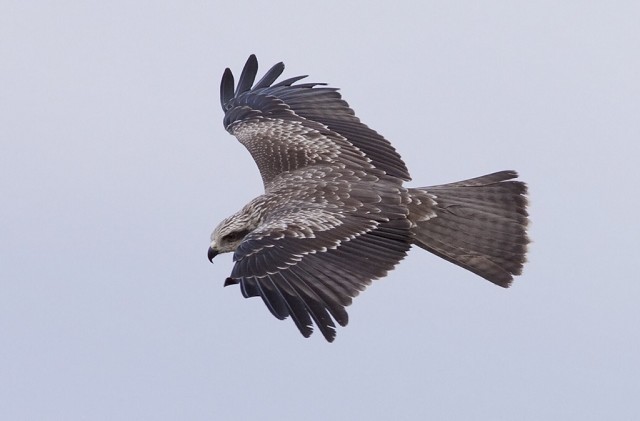
Black Kite, Gigrin Farm, Powys (Photo: Carl)

American Eider (race dresseri), Glassagh Bay, Donegal (Photo: Craig Shaw)

American Eider (race dresseri), Glassagh Bay, Donegal (Photo: Paul Kelly)
Potentially the most exciting birds of the week, though, were the two (or more) possible Middendorf's Bean Geese seen briefly (but photographed) at Sandwick (Shetland) on 13th. These Far-Eastern birds (aligned with the Taiga Bean Goose group) should be wintering in China, Japan or Korea but the party of birds photographed on Shetland seemed to show at least a couple of large birds, with sizeable heads and narrow orange bill-bands. Maybe they were just extreme Taigas, but perhaps they could truly have been Middendorf's.
Off the coast of East Yorkshire, a probable White-billed Diver was reported heading south from Spurn on 11th (it has been a surprisingly lean winter for this magnificent Arctic interloper, one on Shetland in November and December the only confirmed bird(s) of the period).
In Wexford, the single Glossy Ibis remained at Tacumshin to 14th at least. In Somerset, three birds were still at Catcott Lows in the early part of the week and took a flight across Shapwick Heath on 13th and nearby Ham Walls on 16th. Also there was the Great White Egret, one of at least ten birds reported this week. As well as the (now) regular fixtures in Hampshire, Kent, Cambridgeshire, Northamptonshire (two at Pitsford again on 14th) and Glamorgan, additional singles were at Frampton Marsh (Lincolnshire) on 11th, over Ealing Broadway (London) on 12th and at Kidwelly (Carmarthenshire) on 14th.

Great White Egret, Burmarsh, Kent (Photo: Brian Harper)
The same five Cornish Cattle Egrets were still in place this week, two near Sennen and three near Tresillian. Spoonbills noted away from their regular haunts around the southwest included one at Fingringhoe Wick (Essex) on 11th, another remaining in Cheshire and two still in County Cork. In East Sussex, around Piddinghoe, the Common Crane was present throughout the week and the youngster in north Devon remained around the Braunton Marsh area to 15th. New singles were noted in Shropshire (at Wall Farm NR and Kynnersley Moor), Lancashire (Oswaldtwistle) and County Offaly (Ballycon Bog). In Cambridgeshire, four Cranes were at Flag Fen on 12th, and two were again at Eldernell, off and on, through the week.

Spoonbill, Braunton, Devon (Photo: Gary Thoburn)

Common Crane, Braunton Marsh, Devon (Photo: Roy Churchill)
In Scotland, the two blue and one white Snow Geese seen during the last two weeks of January in Aberdeenshire appeared this week in Highland, near Dingwall, on 12th–17th, edging their way ever-so-slightly closer to home. The "intermediate" morph in County Donegal was still at Inch Island Lake from 11th–15th, while lone white birds remained in Norfolk and Argyll and the familiar foursome lingered in Lancashire.

Snow Goose, Inch Levels, Donegal (Photo: Tristan Reid)
Two Richardson's Canada Geese were seen at Ballintemple (Co. Sligo) on 13th, along with the chunky presumed Greater Canada Goose. At Loch Gruinart on Islay a single Richardson's was seen on 11th and 13th, with it (or another) then at Keills on 14th–15th. In Kent, the first-winter hybrid Red-breasted Goose × Brent Goose was still at Shellness (Kent) on 13th and was part of the same flock that also hosted one of the week's (up to) 17 Black Brants. At least five Black Brants were in Norfolk (including three at Wells on 15th, with a fourth just along the way at Burnham Overy), two were in Lincolnshire and perhaps three were in Cork, with singles in East Yorkshire, Kent, Hampshire, Dorset and Wexford (perhaps two birds there). Aghada, the site of one of the Cork sightings, was also home again to the possible Grey-bellied Brant on 11th.

Richardson's Canada Goose, Loch Gruinart RSPB, Islay, Argyll (Photo: Steve Percival)
On Scilly, the drake Black Duck was again on the Abbey Pool, Tresco, on 11th, having last been noted on 20th January; on Bodmin Moor, a drake Black Duck was again at Colliford Reservoir on 16th–17th (presumably the same bird that has appeared occasionally on site since May 2007). In Dumfries & Galloway, a drake American Wigeon was again at Caerlaverock on 15th–17th.
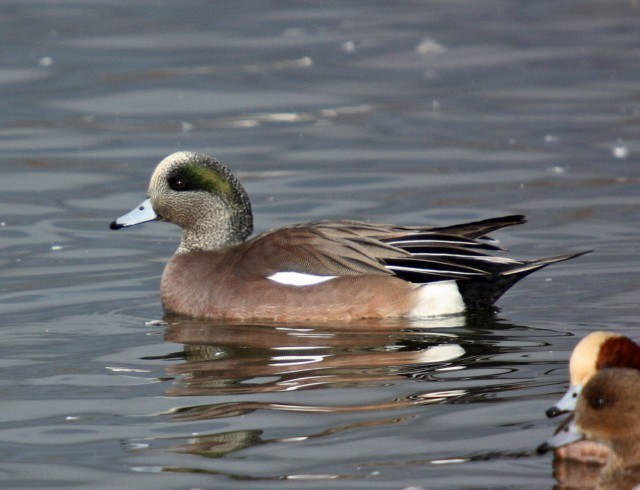
American Wigeon, Caerlaverock WWT, Dumfries & Galloway (Photo: Chris Baines)
Ten Green-winged Teal were reported is week, with new arrivals appearing at both Vane Farm and Loch Leven in Perth & Kinross (presumably the same bird), Slimbridge (Gloucestershire) and Villierstown (Co. Waterford). Others lingered in Hampshire, Leicestershire, Staffordshire, Orkney and Clare, while in Dumfries & Galloway a Green-winged Teal reappeared at Kildrochat on 17th (last seen in December). The female Blue-winged Teal was still on Bull Island (Co. Dublin) on 16th. In Wexford, a drake duck (if you follow!) identified as a Baikal Teal on 5th January reappeared on 13th and was re-identified as a presumed Baikal Teal × Wigeon hybrid.
Late news from last week concerned a pair of Lesser Scaup on Loch nam Faoileag, Lewis (Outer Hebrides) on 10th. This week saw a new bird appear in Glamorgan, a first-winter female at Eglwys Nunydd Reservoir on 13th–14th. The regular drake was also still in the county, spending most of his time on Cosmeston Lakes CP. In Cornwall, the drake Lesser Scaup remained around Colliford Lake to 14th at least.
New drake Ring-necked Ducks were found on Roo Lough (Co. Clare) on 11th, Loch Evelix (Highland) and the Lower Tamar Lakes (Devon) on 12th (the latter bird possibly the bird seen recently in Cornwall, at Porth Reservoir), and Loch Lanlish (Highland) on 15th. Further drakes remained at Cowpen Bewley (Cleveland) and (back again) at Pugney's CP (West Yorkshire) and Inch Island Lake (Co. Donegal). Four females were recorded this week: at Pencarreg Lake (Carmarthenshire), North Ronaldsay (Outer Hebrides) and again at both Slimbridge and Whitlingham Lane, Norwich (Norfolk) on 14th. In Somerset, at the tail end of last week, the drake Ferruginous Duck was reported at Chew Valley Lake.

Ring-necked Duck, Cowpen Bewley, Cleveland (Photo: Mick Brennan)
Surf Scoters this week included two drakes again off Pensarn (Conwy) on 16th and another drake in Lower Largo Bay (Fife) on 13th. The female off Dawlish Warren (Devon) was present all week. The drake King Eider remained off Burghead (Moray) to 12th at least, while the Cleveland Hooded Merganser of presumably dubious origin was at Saltholme Pools on 12th.
An "intermediate"-phase Gyrfalcon was reported twice near Salter's Gate (Co. Durham) on 11th, while, sadly, a white Gyr was found dead on Islay on 14th (the bird seen there over the past three weeks was last reported at Mull of Oa on 9th — whether this is the same bird has yet to be established). Better news from Scilly though: a hale and hearty white-morph Gyr was seen around Tresco on 13th. Three Rough-legged Buzzards continued to move around the adjoining Thorpe and Chedgrave marshes (Norfolk) this week, all still present on 14th, with singles reported to the end of the week. Further Rough-legged Buzzards were seen at Saxby All Saints (Lincolnshire) on 15th and at Hamsterley Forest (Durham) on 16th. A Snowy Owl was on Lewis (Outer Hebrides) on 17th.
In Cornwall, at Maer Lake near Bude, a Long-billed Dowitcher was found on 12th, and was still present to 17th (the first in the county for nearly three years). A second bird was found on 14th at Burton Marsh (Cheshire) but quickly headed north, reappearing at Inner Marsh Farm the following day (two juveniles were seen here in October last year, one remaining to the end of the month). By 16th, it was back again at Burton Marsh.
There was no hint of any late-winter improvement in numbers of white-winged gulls. A grand total of 18 Iceland Gulls and just 16 Glaucous Gulls were recorded, but an adult Kumlien's Gull was found at Killybegs (Co. Donegal) on 15th. Caspian Gulls too featured less frequently than in previous weeks; only 18 or so were noted, but these included two different birds, on consecutive days, for Seaforth (Merseyside) — a first-winter on 12th and an adult on 13th. Two second-winters were at Chasewater (Staffordshire) on 13th, two first-winters were at Appleford (Oxfordshire) on 15th and a couple of birds were in Northamptonshire during the week. A third-winter cachinnans was seen at Hayling Island (Hampshire) and then East Head (East Sussex) on 14th.

Iceland Gull, Plym Estuary, Devon (Photo: Phil Stidwill)
In Essex, two adult Ring-billed Gulls have been seen "recently" on the tip at Pitsea (no public access there sadly), while at Southend-on-Sea "Rossi" the Ring-bill was still in place for another week. An adult Ring-billed Gull was at Copperhouse Creek (Cornwall) on 11th (eeee, just like the old days!) and other grown-ups were still in Hampshire and Argyll. In Ireland, at least 12 birds were seen, with three in Donegal and two each for Derry, Sligo, Galway and Limerick, and one in Antrim. Also in Galway, the adult Forster's Tern remained in the Nimmo's Pier/Mutton Island area all week.

Ring-billed Gull, Donegal, Donegal (Photo: Richard Bonser)
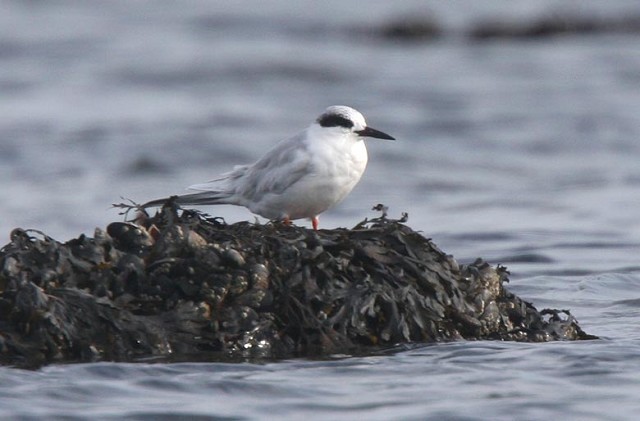
Forster's Tern, Nimmo's Pier, Galway (Photo: Sean Nixon)
Waxwing numbers were up again this week — still not in figures that are ever going to break any records (around 250 noted), but it was nice to see a few flocks around the country, although many sightings were of singletons or very small groups. The largest flocks were 36 in Ashington (Northumberland) on 17th (with another 26 in Jarrow, in Durham, on 14th and 26 in Newcastle-upon-Tyne on 13th), 25+ around Cromer (Norfolk) on 16th, up to 22 in Norwich (Norfolk) on 14th and 20 over Midhope Reservoir (South Yorkshire), also on 14th. Ten were seen at Dungeness (Kent) on 12th, while singles on Shetland and Scilly top-and-tailed things nicely (although the bird in the far west met a sad end, falling into the clutches of a local cat).

Waxwing, Thorpe St. Andrew, Norfolk (Photo: Andy Thompson)
Nine or ten Great Grey Shrikes this week included four in Wales: still at Clocaenog Forest (Clwyd) and Cross Inn Forest (Ceredigion) with two new birds in Powys, at Usk Reservoir on 13th and Mynydd Illtyd on 14th (the former on the border of Powys and Carmarthenshire). In Warwickshire, a Great Grey Shrike was seen near Morton Bagot from 11th and singles elsewhere remained on Bellever Tor (Devon), Alderman's Barrow (Somerset), Holmsley Inclosure (Hampshire) — with another at Burley on 16th — and Ashdown Forest (East Sussex).

Great Grey Shrike, Morton Bagot, Warwickshire (Photo: Max Silverman.)
In Norfolk, a Hume's Yellow-browed Warbler was reported from Strumpshaw Fen on 13th, perhaps the first humei since the surprising mid-May record from last spring when one was trapped and ringed at Kilnsea (East Yorkshire). Details on the Norfolk bird have been scant, though, and no further mention has been made of it. In London, at Walthamstow, a probable Dusky Warbler was seen and heard over 15 minutes on the morning of 14th and then firmed up to a definite the following day, doubtless to the delight of all London birders. This was a first for the capital's recording area and was still present on 17th.
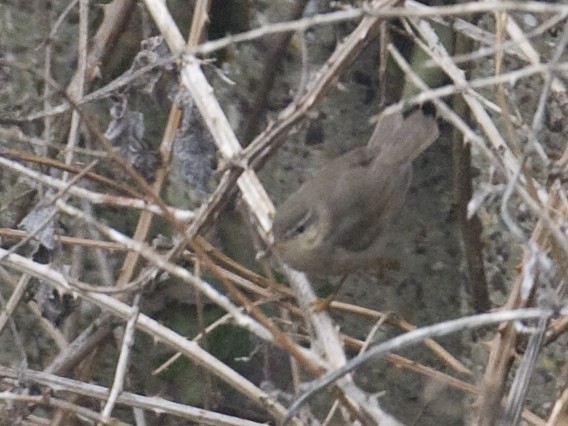
Dusky Warbler, Walthamstow, Greater London (Photo: Roy Woodward)
The female Penduline Tit seen last week at Grove Ferry (Kent) performed pretty well this week, showing daily from 11th–13th, and on 15th one was found at Rainham Marshes (London). Also at Rainham were the two Serins, seen again on 16th. In Cumbria, the first-winter Rose-coloured Starling was seen from 11th–17th and the Little Bunting at Dunnet Bay (Highland) remained to 17th.

Penduline Tit, Grove Ferry NNR, Kent (Photo: Mike Gould)

Rose-coloured Starling, Kendal, Cumbria (Photo: David Brown)
Photo of the Week

Jay, Wyre Forest, Worcestershire (Photo:
John Robinson)
At BirdGuides, we receive plenty of photos of Jays and Great Spotted Woodpeckers separately but, despite the fact that they share the same habitat, it's very unusual to see both species in the same shot. Experienced bird photographer John Robinson made the most of a brief encounter between these two birds in the Wyre Forest, Worcestershire. Shooting through a window, he managed to catch the birds in the middle of a standoff on a snow-covered tree stump. John's shot dynamically captures the action with some great diagonal lines, especially the strong eye-line between the two birds. The domineering pose of the larger Jay as it stares down aggressively at the reeling Woodpecker leaves little doubt as to who would have won the dispute.

Lesser Spotted Woodpecker, undisclosed site, Derbyshire (Photo:
Robert Askew)

Collared Pratincole, Qatar (Photo:
Dileep Kumar)

Barn Owl, undisclosed site, Lancashire (Photo:
Tom Charles)

Red Kite, undisclosed site, Highland (Photo:
Marcus Conway - ebirder)
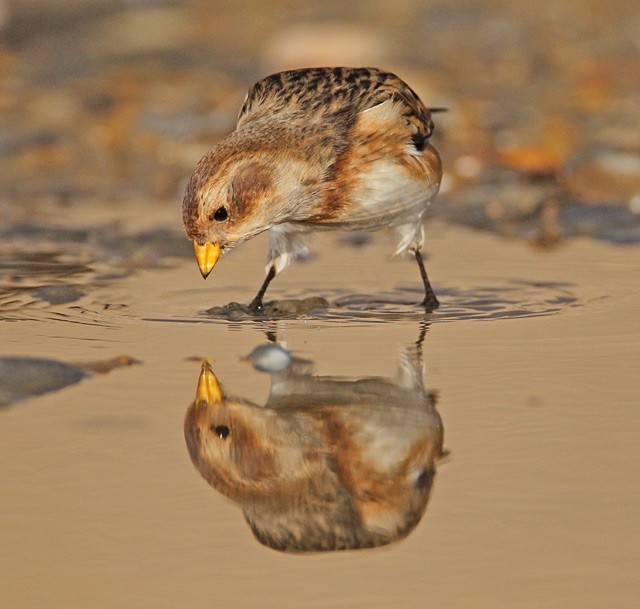
Snow Bunting, Salthouse, Norfolk (Photo:
Chris Upson)

Bittern, Leighton Moss RSPB, Lancashire (Photo:
Tom Charles)

Jay, North Wirral, Cheshire (Photo:
Richard Steel)

Great Tit, Hampton, Worcestershire (Photo:
Mark Hancox)

Sparrowhawk, Cleveleys, Lancashire (Photo:
David Moreton)

Nuthatch, undisclosed site, Staffordshire (Photo:
Steve Round)

Common Kingfisher, Alphington, Devon (Photo:
Charlie Fleming)

Red Grouse, undisclosed site, Highland (Photo:
Mark Wilson)
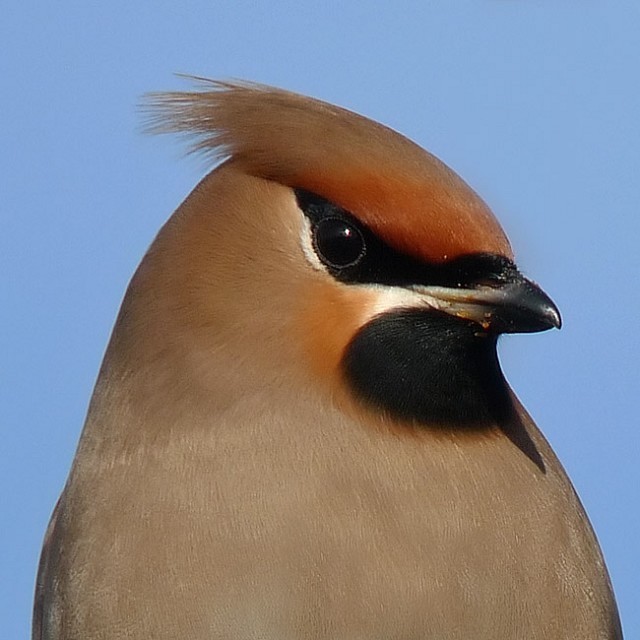
Waxwing, Boston, Lincolnshire (Photo:
Russell Hayes)
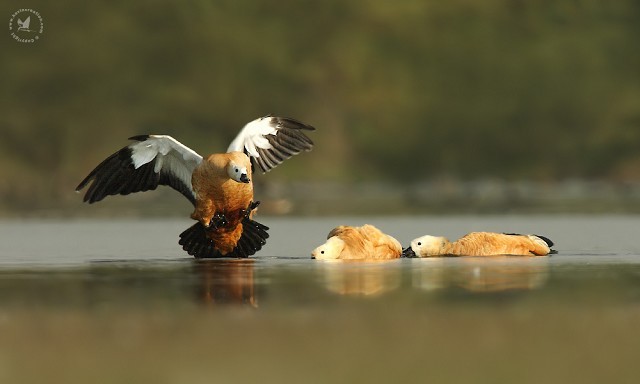
Ruddy Shelduck, India (Photo:
Mital Patel)

Pochard, Welney WWT, Norfolk (Photo:
Garth Peacock)

Goldfinch, Cleveleys, Lancashire (Photo:
Jackie Moreton)

Lesser Redpoll, Llandrindod Wells, Powys (Photo:
Kev Joynes)

